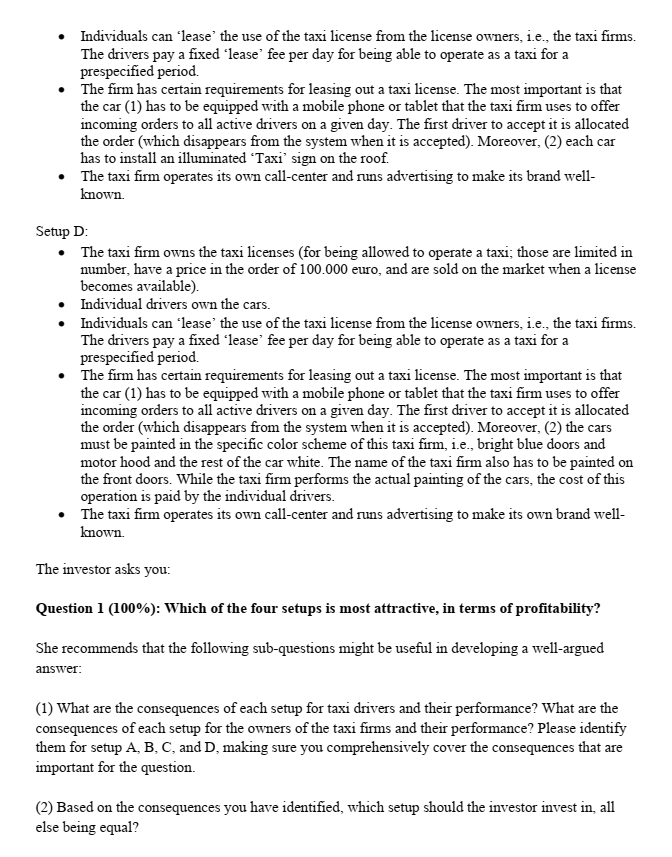According to the course in foundations of organization with main topics in the syllabus is listed below. How can these questions be answered (maybe it is not relevant to include all topics. I need a detailed answer.
- coordination, division of labor and of knowledge. - cooperation, authority, hierarchy, the agency problem, and transaction cost economics - competences in organizations (organizations as information-processing systems, organizations as bundles of competences and routines, and organizational learning


Taxi Inc. You are a consultant to an investor who wants to invest in the taxi business. Whether correct or not, her idea is that despite a growth in ridesharing services, there is and will be a considerable number of potential customers that prefer taxis. She therefore wants to invest in a taxi business. The investor has noted that there are different organizational setups for taxi operations in the country of Krakoa, where she wants to invest. (In Krakoa, fares for taxi rides are regulated, i.e., all taxis have to charge the same price for a certain ride.) The investor asks for your advice regarding which setup to pick and why. Understanding the arguments for and against each is particularly important for her. Setup A: The taxi firm owns the cars and the taxi licenses (for being allowed to operate a taxi; those are limited in number, have a price in the order of 100.000 euro, and are sold on the market when a license becomes available). Drivers are employed by the taxi firm, with fixed employment contracts (unlimited duration). The employment contract stipulates a fixed salary for taxi drivers, plus overtime supplements and supplements for nightshifts and weekend shifts. The taxi firm operates its own call-center to take orders. Moreover, the taxi firm runs advertising to increase awareness about the taxi firm. Rides are allocated by the firm's headquarters and communicated via an internal system installed in all taxis. The system informs each taxi where to pick up the next customer. A computer program at headquarters matches incoming orders with the location and availability of each taxi. Setup B: The individual drivers own their car and the taxi license (for being allowed to operate a taxi; those are limited in number, have a price in the order of 100.000 euro, and are sold on the market when a license becomes available). The individual drivers have formed cooperatives. Each cooperative has its own brand and operates a call center through which each cooperative offers orders to its individual members, in the following way: The call center announces orders on an internal (to the specific cooperative) system built into each taxi. The first driver to accept the trip is allocated the order (which disappears from the system when it is accepted). The cooperative operates the call center and runs branding and advertising, the individual taxi drivers pay a membership fee that pays for these activities; the membership fee is fixed and equal for each member. Setup C The taxi firm owns the taxi licenses (for being allowed to operate a taxi, those are limited in number, have a price in the order of 100.000 euro, and are sold on the market when a license becomes available) Individual drivers own the cars. Individuals can lease the use of the taxi license from the license owners, i.e., the taxi firms. The drivers pay a fixed lease' fee per day for being able to operate as a taxi for a prespecified period. The firm has certain requirements for leasing out a taxi license. The most important is that the car (1) has to be equipped with a mobile phone or tablet that the taxi firm uses to offer incoming orders to all active drivers on a given day. The first driver to accept it is allocated the order (which disappears from the system when it is accepted). Moreover, (2) each car has to install an illuminated Taxi' sign on the roof. The taxi firm operates its own call-center and runs advertising to make its brand well- known. Setup D: The taxi firm owns the taxi licenses (for being allowed to operate a taxi; those are limited in number, have a price in the order of 100.000 euro, and are sold on the market when a license becomes available). Individual drivers own the cars. Individuals can lease the use of the taxi license from the license owners, i.e., the taxi firms. The drivers pay a fixed lease' fee per day for being able to operate as a taxi for a prespecified period. The firm has certain requirements for leasing out a taxi license. The most important is that the car (1) has to be equipped with a mobile phone or tablet that the taxi firm uses to offer incoming orders to all active drivers on a given day. The first driver to accept it is allocated the order (which disappears from the system when it is accepted). Moreover, (2) the cars must be painted in the specific color scheme of this taxi firm, i.e., bright blue doors and motor hood and the rest of the car white. The name of the taxi firm also has to be painted on the front doors. While the taxi firm performs the actual painting of the cars, the cost of this operation is paid by the individual drivers. The taxi firm operates its own call-center and runs advertising to make its own brand well- known The investor asks you: Question 1 (100%): Which of the four setups is most attractive, in terms of profitability? She recommends that the following sub-questions might be useful in developing a well-argued answer: (1) What are the consequences of each setup for taxi drivers and their performance? What are the consequences of each setup for the owners of the taxi firms and their performance? Please identify them for setup A, B, C, and D, making sure you comprehensively cover the consequences that are important for the question. (2) Based on the consequences you have identified, which setup should the investor invest in all else being equal? Taxi Inc. You are a consultant to an investor who wants to invest in the taxi business. Whether correct or not, her idea is that despite a growth in ridesharing services, there is and will be a considerable number of potential customers that prefer taxis. She therefore wants to invest in a taxi business. The investor has noted that there are different organizational setups for taxi operations in the country of Krakoa, where she wants to invest. (In Krakoa, fares for taxi rides are regulated, i.e., all taxis have to charge the same price for a certain ride.) The investor asks for your advice regarding which setup to pick and why. Understanding the arguments for and against each is particularly important for her. Setup A: The taxi firm owns the cars and the taxi licenses (for being allowed to operate a taxi; those are limited in number, have a price in the order of 100.000 euro, and are sold on the market when a license becomes available). Drivers are employed by the taxi firm, with fixed employment contracts (unlimited duration). The employment contract stipulates a fixed salary for taxi drivers, plus overtime supplements and supplements for nightshifts and weekend shifts. The taxi firm operates its own call-center to take orders. Moreover, the taxi firm runs advertising to increase awareness about the taxi firm. Rides are allocated by the firm's headquarters and communicated via an internal system installed in all taxis. The system informs each taxi where to pick up the next customer. A computer program at headquarters matches incoming orders with the location and availability of each taxi. Setup B: The individual drivers own their car and the taxi license (for being allowed to operate a taxi; those are limited in number, have a price in the order of 100.000 euro, and are sold on the market when a license becomes available). The individual drivers have formed cooperatives. Each cooperative has its own brand and operates a call center through which each cooperative offers orders to its individual members, in the following way: The call center announces orders on an internal (to the specific cooperative) system built into each taxi. The first driver to accept the trip is allocated the order (which disappears from the system when it is accepted). The cooperative operates the call center and runs branding and advertising, the individual taxi drivers pay a membership fee that pays for these activities; the membership fee is fixed and equal for each member. Setup C The taxi firm owns the taxi licenses (for being allowed to operate a taxi, those are limited in number, have a price in the order of 100.000 euro, and are sold on the market when a license becomes available) Individual drivers own the cars. Individuals can lease the use of the taxi license from the license owners, i.e., the taxi firms. The drivers pay a fixed lease' fee per day for being able to operate as a taxi for a prespecified period. The firm has certain requirements for leasing out a taxi license. The most important is that the car (1) has to be equipped with a mobile phone or tablet that the taxi firm uses to offer incoming orders to all active drivers on a given day. The first driver to accept it is allocated the order (which disappears from the system when it is accepted). Moreover, (2) each car has to install an illuminated Taxi' sign on the roof. The taxi firm operates its own call-center and runs advertising to make its brand well- known. Setup D: The taxi firm owns the taxi licenses (for being allowed to operate a taxi; those are limited in number, have a price in the order of 100.000 euro, and are sold on the market when a license becomes available). Individual drivers own the cars. Individuals can lease the use of the taxi license from the license owners, i.e., the taxi firms. The drivers pay a fixed lease' fee per day for being able to operate as a taxi for a prespecified period. The firm has certain requirements for leasing out a taxi license. The most important is that the car (1) has to be equipped with a mobile phone or tablet that the taxi firm uses to offer incoming orders to all active drivers on a given day. The first driver to accept it is allocated the order (which disappears from the system when it is accepted). Moreover, (2) the cars must be painted in the specific color scheme of this taxi firm, i.e., bright blue doors and motor hood and the rest of the car white. The name of the taxi firm also has to be painted on the front doors. While the taxi firm performs the actual painting of the cars, the cost of this operation is paid by the individual drivers. The taxi firm operates its own call-center and runs advertising to make its own brand well- known The investor asks you: Question 1 (100%): Which of the four setups is most attractive, in terms of profitability? She recommends that the following sub-questions might be useful in developing a well-argued answer: (1) What are the consequences of each setup for taxi drivers and their performance? What are the consequences of each setup for the owners of the taxi firms and their performance? Please identify them for setup A, B, C, and D, making sure you comprehensively cover the consequences that are important for the question. (2) Based on the consequences you have identified, which setup should the investor invest in all else being equal








